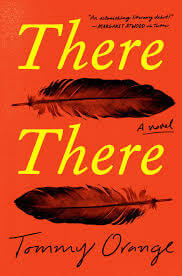There There
by Tommy Orange
Reviewed by Abeer Hoque
“You were white, you were brown, you were red, you were dust.”
I had been enthusiastically recommended There There by Tommy Orange a few times before I picked it up. There are precious few Native books in the American literary canon, let alone the particular and fascinating urban Indian perspective that Orange lays out. There There is a novel based in Oakland, California, and it is a different Bay Area than the reader might expect: gritty, working class, profane, revelatory. There is a profound sense of history throughout, a virtually untold version by people who have survived despite “a five-hundred-year-old genocidal campaign.”
Each chapter of There There is from the point of view of a different Native character, and it’s only halfway through that the characters start to repeat and connect. This is also when the narrative starts to coalesce and grow in power and meaning. There is a hurtling quality in the second half of the book with a sense of menace that grows as the reader is drawn deeper into each character’s life. Orange has extraordinary facility depicting people with a wide range of ages, as well as female and male characters. It reminds me of Booker Award winner Bernadette Evaristo’s novel Girl Woman Other, another tour de force novel of many characters telling one loosely linked story.
Addiction, alcoholism, and mental illness are often associated with Native populations without the necessary context of brutal colonial/settler politics as well as the vast and deep systemic inequities that Native Americans have suffered and still do. Orange takes the political and makes it so deeply personal that in some ways, his characters take more credit than seems fair: “It took the edge off, and it allowed her to say and do whatever she wanted without feeling bad about it.” Throughout the book, history begets itself through intergenerational trauma, self-medication, shame, and silence: “it’s that you get stuck, and then the more stuck you get, the more stuck you get.”
I don’t want to undersell the driving story of There There. The characters are a vibrant diverse ensemble and their arcs twist and grow into a multi-layered narrative. Towards the end of the book, I couldn’t stop reading, both because of the quickening thickening plot but also because I had become enmeshed in the characters’ lives. I also loved how dance was an ever-present theme – there was an entire section which seemed to be written in rhythm: “You were finding out that everything makes a sound. Everything can be drumming whether rhythm is kept or strays. Even gunshots and backfire, the howl of trains at night, the wind against your windows. The world is made of sound.”
Resilience is perhaps the most poignant theme that Orange repeats throughout: “We all fuck up. It’s how we come back from it that matters.” This is of course a matter of survival, of life and death, “a world made for Native people not to live but to die in, shrink, disappear.” It’s a lesson they had to learn, and that there is yet so much pride and joy and deep culture is testament to their spirit and strength. But the lesson looms as large or larger for everyone else, because if you live in America, no matter who you are or where you come from, you are complicit in the daily and historical “genocidal campaign” against the first Americans. The best we can do is actively interrupt the racist system whenever we see it. Part of that is even becoming aware of these histories. I’m so glad for There There, to walk a while with Jacquie Red Feather, Dene Oxendene, Loother and Lony, and Opal Viola Victoria Bear Shield. Orange says, “it turns out that who you spend time with ends up mattering more than what you do with that time.” That’s certainly a first step.

There There
Tommy Orange
Random House LLC
ISBN: 978-05255203750
About the Author
 Abeer Hoque is a Nigerian born Bangladeshi American writer and photographer. She is the author of a monograph of travel photography and poems (The Long Way Home, 2013), a linked stories collection (The Lovers and the Leavers, 2015), and a memoir (Olive Witch, 2017). See more at olivewitch.com.
Abeer Hoque is a Nigerian born Bangladeshi American writer and photographer. She is the author of a monograph of travel photography and poems (The Long Way Home, 2013), a linked stories collection (The Lovers and the Leavers, 2015), and a memoir (Olive Witch, 2017). See more at olivewitch.com.
